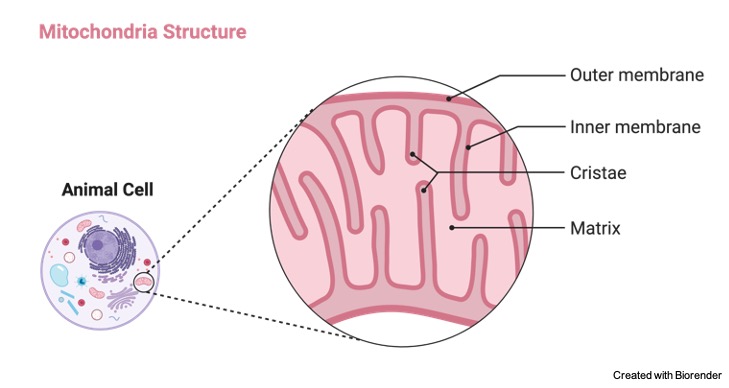What is Mitochondria?
Almost all eukaryotic cells required mitochondria for the production of energy in the form of adenosine triphosphate (ATP) an energy-rich molecule that powers basic cell processes.
Therefore, known as the cell’s powerhouse. Mitochondria is a rod shaped membrane bound organelle that range in size from 0.5 to 10 m.
Mitochondria are highly dynamic and their number in a cell is determined by the metabolic needs of that cell i.e. Red blood cells in humans lacks mitochondria, whereas thousands of mitochondria are found in liver cells and muscle cells.
The oxymonad Monocercomonoides species is the only known eukaryotic species without mitochondria.
Evolution of Mitochondria
The evolution of mitochondria is supported by endo-symbiotic theory. It is assumed that evolution of mitochondria took place from free living bacteria in a long process of millions of years and now mitochondria has become inseparable part of cell.
Structure of Mitochondria
Mitochondria is separated by double-membrane system by the cytoplasm consisting of outer and inner mitochondrial membranes separated by an inter-membrane gap.
Outer membrane is porous and made up of protein and phospholipids. Small molecules, ions, uncharged molecules can pass through the outer mitochondrial membrane through pore forming membrane proteins (porins).
The inner membrane is selectively permeable, it also have especial enzyme called ATP synthase which play significant role in ATP synthesis.
Inner membrane of mitochondria possesses several tubular invagination folds called cristae that extend into the organelle’s interior (matrix) and allowing only very small molecules, ions via specific membrane transport proteins and bears electron transport chain.
The mitochondrial matrix is the space filled with viscous fluid within inner membrane it comprises mitochondrial DNA, enzymes for kerbs cycle (TCA) cycle, ribosomes, proteins, inorganic ions, organic compounds, nucleotide cofactors compounds.
Each of these components serves a specific purpose. A synchronisation between compartments in mitochondria generate ATP following a complex multistep process.
Vernalization: Definition, Hormone, and Mechanism
Mitochondrial DNA and its Inheritance
A surprising feature of mitochondria is that it has its own circular DNA which independently reproduces.
Mitochondria DNA have 37 genes and almost 16,500 DNA base pair in humans, required for proper mitochondrial function.
Maternal lineage is the primary source of mitochondrial inheritance in most animal species, although paternal passage of mitochondrial inheritance in very few cases is also confirmed is by some latest research.
Mitochondria is found in a sperm’s tail as a energy reservoir for the sperm’s long journey to the egg.
The tail of the sperm slips off when it connects to the egg during fertilisation. As a result, the zygotes only source of mitochondria is usually the egg delivered by its mother.
Unlike nuclear DNA shuffling of mitochondrial DNA doesn’t take place in every generation so slower rate of change can be anticipated, which make it important for human evolution studies
Function of Mitochondria
Mitochondria synthesize ATP through aerobic cellular respiration.
In mitochondria matrix glucose is oxidised in pyruvate and form acetyl co-enzyme and produced reduced NADH through citric acid cycle which later on transfer electron to inner membrane embedded protein system (ETC) used in the process of oxidative-phosphorylation and synthesize ATP via ATP synthase enzyme present in mitochondrial inner membrane.
Besides energy production mitochondria also perform other important roles for eg. calcium storage for cell signalling, oxidative stress control, cellular metabolism, heat generation, cell growth, programme cell death.
Susceptibility of Mitochondria for Toxic Insult
The DNA within mitochondria is more vulnerable to damage than the rest of the genome. During ATP synthesis the generation of free radical can damage DNA.
Although most of the mitochondrial malfunction are caused by changes in nuclear DNA that effects mitochondrial functions.
These mutations can be inherited or occur naturally. Any damage to mitochondria results in energy-depleted cells which eventually leads to cell death.
In general, cells that require the most energy, such as heart muscle cells and nerve cells, are the most harmed by defective mitochondria.
Mitochondrial Malfunction Disease
Parkinson’s disease (PD), bipolar illness, schizophrenia, Alzheimer’s disease (AD), Huntington’s diabetes, autism.
Mitochondrial DNA is also employed in forensic science to identify bodies or sections of bodies.
Mitochondrial Function in Aging
Researchers have been looking into a link between mitochondrial malfunction and aging in recent years.
There are many ideas about aging, and the mitochondrial free radical theory of aging has gained popularity in recent years.
Reactive oxygen species (ROS) are thought to be created as a by-product of energy synthesis in mitochondria. DNA, lipids, and proteins are all harmed by these highly charged particles.
The functioning portions of mitochondria are damaged as a result of ROS damage. When the mitochondria can no longer operate properly, more ROS is created, which exacerbates the damage.
Although there has been evidence of a link between mitochondrial activity and aging, not all experts have reached the same findings. It’s yet unclear what role they play in the aging process.
Mitochondria Citations
- Our (Mother’s) Mitochondria and Our Mind. Perspect Psychol Sci . 2018 Jan;13(1):88-100.
- Mitochondria: in sickness and in health. Cell . 2012 Mar 16;148(6):1145-59.

